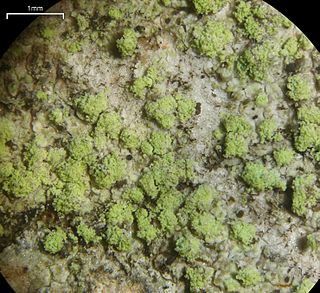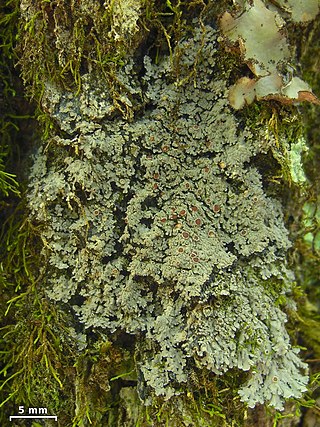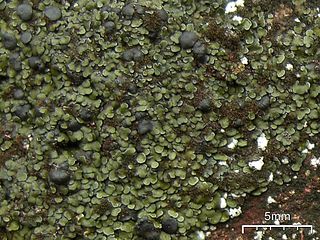
The Pannariaceae are a family of lichens in the order Peltigerales. Species from this family have a widespread distribution, but are especially prevalent in southern temperate regions.

Biatora is a genus of lichens in the family Ramalinaceae. First described in 1817, the genus consists of crustose and squamulose lichens with green algal photobionts, biatorine apothecia, colorless, simple to 3-septate ascospores, and bacilliform pycnospores. According to the Dictionary of the Fungi, the genus contains 42 species that are widely distributed in temperate areas.

Ochrolechia is a genus of crustose lichens in the family Ochrolechiaceae.

Fuscopannaria is a genus of lichen-forming fungi in the family Pannariaceae. It has 55 species.

Miriquidica is a genus of lichen in the family Lecanoraceae. The genus was circumscribed in 1987 by lichenologists Hannes Hertel and Gerhard Rambold, with Miriquidica complanata assigned as the type species. According to Dictionary of the Fungi, the widespread genus contains 23 species, found predominantly in arctic-alpine regions.
Sagiolechia is a genus of lichen-forming fungi in the family Sagiolechiaceae. The genus was circumscribed by lichenologist Abramo Bartolommeo Massalongo in 1854, who assigned Sagiolechia protuberans as the type species. The family Sagiolechiaceae was proposed in 2010 to contain Sagiolechia as the type genus, and genus Rhexophiale; molecular phylogenetic analysis showed that these two genera formed a distinct clade in the Ostropales.

Spilonema is a genus of lichen-forming fungi in the family Coccocarpiaceae. The genus was circumscribed by Jean-Baptiste Édouard Bornet in 1856.

Placynthium is a genus of lichen-forming fungi in the family Placynthiaceae. Members of this genus are commonly called blackthread lichens.
Xenonectriella is a genus of lichenicolous fungi in the family Nectriaceae. The genus was circumscribed by lichenologist Josef Karl Weese in 1919, with Xenonectriella lutescens assigned as the type species.

Coccotrema is a genus of lichen-forming fungi. It is the type genus of the family Coccotremataceae, in the order Pertusariales. The genus contains 16 species.

Corticifraga is a genus of lichenicolous fungi in the family Gomphillaceae. The genus was circumscribed by David Leslie Hawksworth and Rolf Santesson in 1990, with Corticifraga peltigerae assigned as the type species.

Lambiella is a genus of lichen-forming fungi in the family Xylographaceae. The genus was circumscribed by German botanist Hannes Hertel in 1984, with Lambiella psephota assigned as the type species.
Toensbergia is a genus of lichen-forming fungi in the family Sporastatiaceae. The genus was circumscribed by Mika Bendiksby and Einar Timdal in 2013. The genus name honours Norwegian lichenologist Tor Tønsberg, "in appreciation of his important work on sorediate, corticolous lichens". The type species is Toensbergia leucococca, which was formerly classified in genus Hypocenomyce, presumably due to its resemblance to Hypocenomyce xanthococca.
Atrophysma is a fungal genus in the family Pannariaceae. It contains the single species Atrophysma cyanomelanos, a crustose lichen found only in Alaska.
Hydropunctaria alaskana is a species of crustose lichen in the family Verrucariaceae. Found in Alaska, it was described as a new species in 2020 by Holger Thüs and Sergio Pérez-Ortega. The type specimen was collected from the Hoonah-Angoon Census Area in Glacier Bay National Park, where it was found growing on metamorphic rocks beside a creek. Buellia coniops and Verrucaria aethiobola were other lichens on the same rock. Hydropunctaria alaskana is also known to occur on Mitkof Island in Alaska, and on Vancouver Island in British Columbia.
Lambiella aliphatica is a species of crustose lichen in the family Xylographaceae. Found in Alaska, it was described as a new species in 2020 by Toby Spribille and Philipp Resl. The type specimen was collected in the Hoonah-Angoon Census Area of Glacier Bay National Park. Here it was found at an altitude of 907 m (2,976 ft) growing on an argillite rock in alpine scree. The specific epithet aliphatica refers to the unidentified fatty acids that are present in the thallus. It is the first member of genus Lambiella to contain primarily fatty acids in the thallus. Lambiella globulosa is similar in morphology, but this species contains stictic acid rather than fatty acids as the primary secondary metabolite.
Lecanora viridipruinosa is a species of crustose lichen in the family Lecanoraceae. Found in Alaska, it was formally described as a new species by lichenologists Måns Svensson and Toby Spribille. The type specimen was collected from the Hoonah-Angoon Census Area in Glacier Bay National Park. Here it was found growing on exposed argillite rock in an alpine heath at an elevation of 920 m (3,020 ft). The specific epithet viridipruinosa refers to the greenish pruina on the discs of the apothecia. The lichen is only known to occur in the type locality.
Steineropsis laceratula is a species of crustose placodioid lichen in the family Pannariaceae. It was first formally described in 1902 by French lichenologist Auguste-Marie Hue as Pannaria laceratula. Per Magnus Jørgensen proposed a transfer to Fuscopannaria in 1994. The taxon shuffled genera again in 2020 by Toby Spribille and Stefan Ekman after molecular phylogenetic analysis of the DNA from specimens collected in Alaska revealed its correct classification in the genus Steineropsis. The type specimen was collected in 1904 from Hakkoda, Japan, at an elevation of 1,200 m (3,900 ft); here the lichen was found growing on the bark of birch, but the species also grows on rock.
Ochrolechia minuta is a species of crustose lichen in the family Ochrolechiaceae. It was first formally described in 1938 by Swedish lichenologist Gunnar Degelius as Perforaria minuta. The type specimen was collected from the Kodiak Island Borough in Alaska. Toby Spribille transferred it to the genus Ochrolechia in 2020, suggesting that the absence of cephalodia, and the presence of alectoronic acid, indicate that it is "related to the alectoronic acid-containing species of poriform Ochrolechia".
Pertusaria mccroryae is a species of white or greenish-white crustose lichen. It is found in northwestern North America, in forests with old trees. It grows from low elevation to 1,700 m (5,600 ft) on the bark of living trees or on logs, and is named in honor of Colleen McCrory, a Canadian environmental activist. The spore size and the chemistry distinguish it from other members of the genus.









